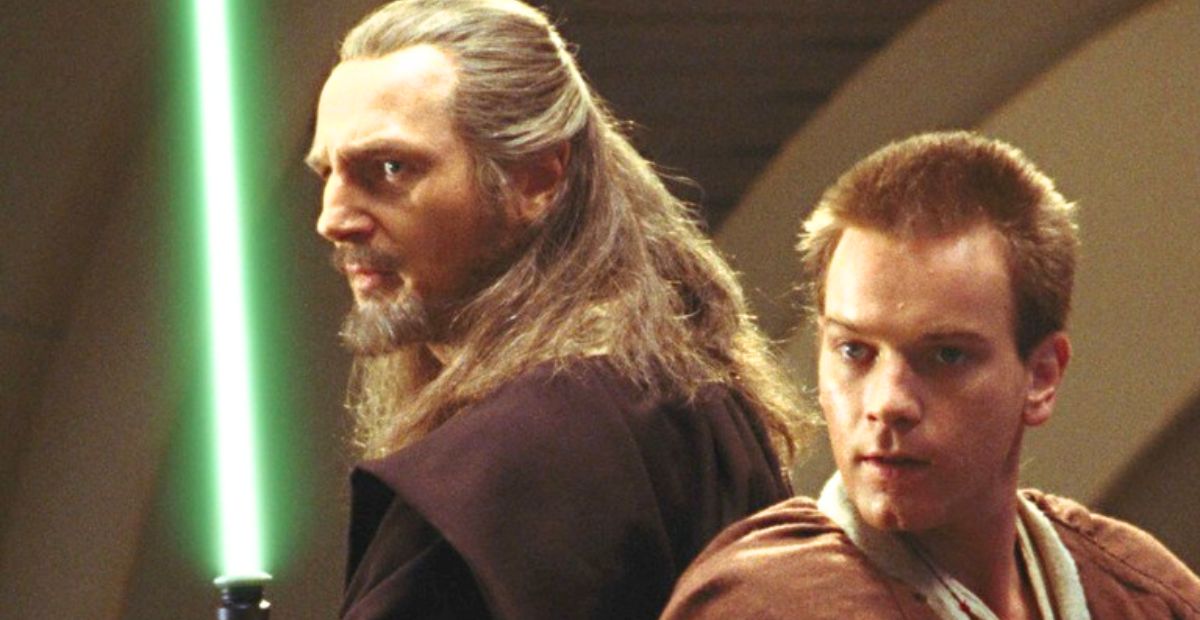As The Phantom Menace celebrates its 25th birthday this year, we can consider some interesting details about this first sequel.
Darth Maul was introduced as a new villain, and Obi-Wan was going to be named Qui-Gon. What would this name change have meant? Read on to find out more.
Obi-Wan as Qui-Gon and Qui-Gon as Obi-Wan
Recent news stories have conveyed how George Lucas made a change to the two main Jedi in The Phantom Menace.
Lucas originally envisioned that “the roles of Jedi Master and apprentice would be changed around in the film, with the apprentice taking on his Master’s name in the end.”
During the development of the first prequel, that was the running plan.
Liam Neeson would play Obi-Wan and Ewan McGregor would have been Qui-Gon, until Obi-Wan loses to Darth Maul in their duel, and Qui-Gon takes the other name, Obi-Wan, “as a tribute.” Yet, the movie evolved differently.
One recent article explores the design process behind bringing Darth Maul to life. Artist Iain McCaig indicates how forging Maul’s appearance pushed him into new creative terrain because this villain was not flushed out.
Likewise, McCaig describes how the characters Qui-Gon and Obi-Wan evolved. Initially, “the older Jedi was named Obi-Wan and the younger Jedi was named Qui-Gon.”
Like Maul, these two characters were in the realm of ideas and speculation in 1995, four years before the film’s release.
Yet, these original names stayed in place close to filming when George Lucas swapped them.
That late change helps explain a famous line in A New Hope. When Luke encounters Obi-Wan for the first time on Tatooine, he asks about Obi-Wan Kenobi. Kenobi responds, “Now that’s a name I have not heard for a long time…long time.”
We may think that is because he distanced himself from that person, but it could mean he is thinking about his lost mentor who would have been Obi-Wan according to original plans.
As McCraig explains, that line arises from Obi-Wan in A New Hope because he is really Qui-Gon. It may be that he was not thinking about how he had not gone by that name in about 20 years after all.
However, fans are quick to point out that Obi-Wan quickly claims that name and identity when he responds: “Of course I know him. He’s me.”
So, that extended line of thinking about them switching places does not quite hold up, but it is interesting that they nearly reversed their names.
Could The Name Changes Have Worked?
The above discussion board also conveys that this name change could have worked. That is, “Liam Neeson’s character” could have been “introduced as ‘Obi Wan Jin’ and Ewan McGregor’s character” was called “Ben Kenobi.”
Yet, when Ben becomes a Jedi and has his own apprentice, he could become known as Obi Wan Kenobi.
The names could have thus served as a rite of ascension, a progression from apprentice to Jedi Knight. Other fans tend to agree.
A separate discussion posits that “the names” turn “into titles” and there “would always be a ‘Master Obi-Wan’ regardless of who it was.” The names become placeholders rather than indicating a specific character.
Then again, other fans from above indicate how it would be confusing. At the end of Revenge of the Sith, for example, the dialogue would be circuitous, with Yoda “telling Obi-Wan that he has to communicate with his old Master” or Master Obi-Wan has to get in touch with Master Obi-Wan.
A Rose By Any Other Name
According to Shakespeare’s Juliet, “A rose by any other name would smell as sweet.” We may use this quote as an analogy for thinking that regardless of their names, the characters would still be the same even if they had swapped names.
And, if these original plans for the names had remained, it may have worked as a way to pass on a title to the next generation.
Yet, it would have probably been confusing and perhaps disrupted the character formation. As fans and viewers, we are better off with the name change.

